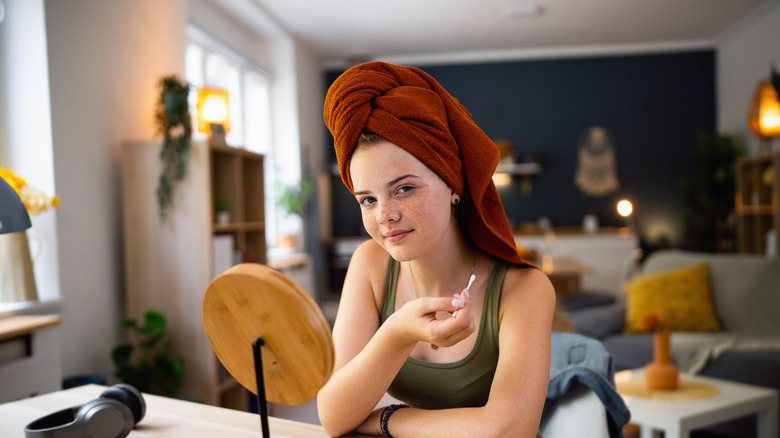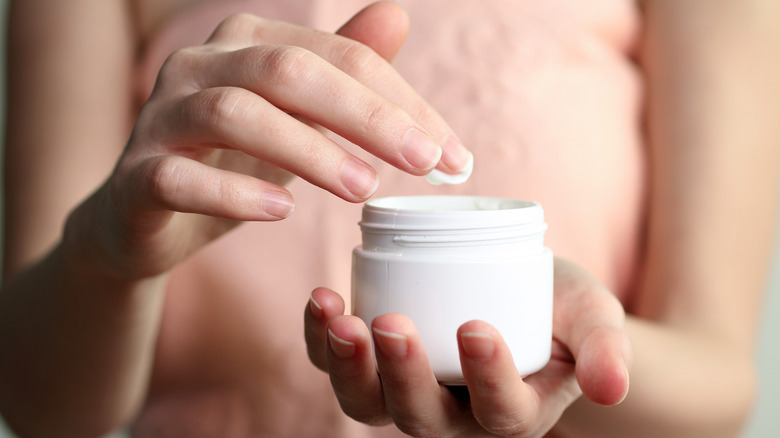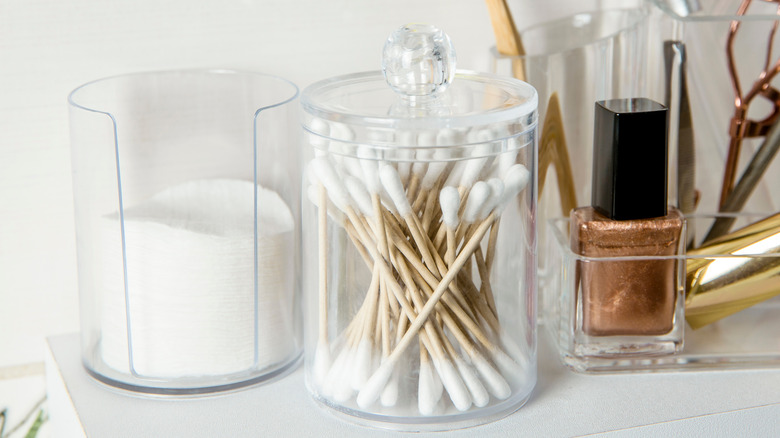How To Keep Your Bathroom Products Sanitary With Q-Tips
Perhaps you've heard the cautionary tale against storing your toothbrush out in the open on your bathroom counter. Unfortunately, there's a great deal of truth to this tale. When we flush the toilet, tiny particles of fecal matter can travel more than 6 feet through the air and settle on nearby surfaces, your toothbrush, and any other surrounding bathroom products (via Life Dental Group). If you're keeping your favorite gels and creams situated near the toilet, this is certainly one way in which they can become contaminated. Yet there are other sneaky ways in which you may be contaminating your bathroom products without even realizing it.
If you're dabbing your fingertips right into your product containers, you're likely transferring germs directly into the jar each time you do. Very quickly, your tub of lotion can become home to a host of different bacteria. "This sort of thing was first noticed in eczema patients who regularly apply cream to their skin," Dr. Susan Mayou, consultant dermatologist at London's Cadogan Clinic, told Daily Mail. "It became apparent that they were constantly reinfecting themselves." Using a cotton swab instead of our fingers, however, can help reduce the risk of contamination.
Think twice before sticking fingers in products
We get it. Scooping out moisturizer with a Q-tip instead of your fingers certainly seems more tedious. You may be wondering then, is using our fingers really all that bad? In a 2015 scientific review published in the Journal of Dermatological Science, the study team looked at various research articles published between 2008 and 2015 regarding the human hand microbiome. Across 11 studies, findings revealed that human hands harbored an average of eight to 24 different families of bacteria. The researchers noted that people who work in restaurants or medical facilities are at an increased risk for carrying hand pathogens, such as antibiotic-resistant Staphylococcus aureus or Escherichia coli bacteria.
Okay, but washing our hands before sticking our fingers into our tub of hair gel will fix this problem, right? While the researchers noted that some studies have shown hand-washing and the use of hand-sanitization products can decrease hand-pathogen count, other studies have shown that frequent hand-washers or users of these products may actually harbor more hand pathogens. According to Allure, even if you or a buddy were to clean your hands before using bathroom products with open tops, germ transfer is still likely to take place.
Use a cotton swab to scoop product from the jar
Fungi and bacteria can easily set up camp along the insides of bathroom product containers due to their lack of airtight sealing, particularly in warm, moist environments (via Allure). While many commercial products utilize preservatives to protect against bacteria growth, these chemicals may not always be effective in combating pathogens from human use. Researchers from a 2019 study published in Physiotherapy Theory and Practice tested more than 80 used lotion containers across 22 different outpatient rehabilitation clinics. They found 16 of the containers to be contaminated with bacteria. The grooves of the lotion containers harbored the greatest amount of germs. When the study team tested the efficacy of the product's preservatives by introducing bacteria into unused, unopened lotion containers, the preservatives were ineffective in eliminating the bacteria.
Applying contaminated bathroom products to our body can leave skin irritated, red, and acne-prone, explains Women's Health. To help keep your products sanitary, allow a cotton swab to serve as a middleman between the product and your fingers. Use a Q-tip to scoop product out from the jar as needed, apply it, and discard the swab. If you need more product, pull out a fresh Q-tip. You won't want to use the same swab twice.



